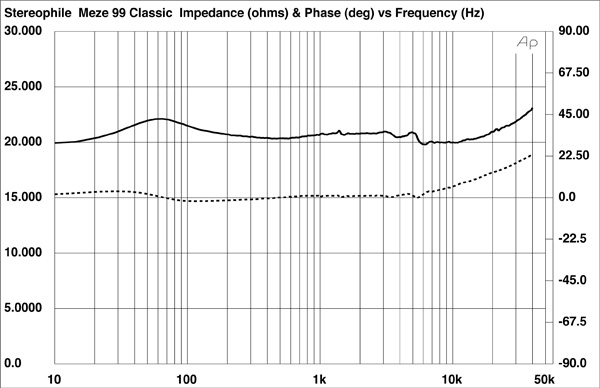| Columns Retired Columns & Blogs |
Measurements for all the headphones mentioned in this review, including Meze 99 Classics are available on Inner/Fidelity website :-) .........
I didn't measure the Meze Audio 99 Classics' frequency response; I lack the necessary simulated head and torso, and estimating the optimal response of headphones is far from simple. However, I measured the 99 Classics' impedance and electrical phase with the headphones mounted on my head (fig.1. The electrical phase angle was close to 0° up to 6kHz, suggesting that the drive-unit behaves as a pure resistor up to that frequency; the slightly positive angle that increases above 6kHz is due to the driver's residual inductance. The impedance magnitude was a fairly constant 21 ohms through most of the audioband, but with a slight bump in the midbass centered on 60Hz. This suggests that this is the tuning frequency of the diaphragm. The 99 Classics have a relatively low impedance; they'll need to be driven by an output stage capable of delivering enough current into this load.

Ken Micallef reported that "even at loud volumes the 99s kept their cool, never sounding shouty, edgy, boxy, or otherwise criminal in the treble." However, a kink in the impedance-magnitude trace at 1.5kHz and a couple of discontinuities in the mid-treble imply the presence of some resonances.
I gave the Meze 99 Classics a listen using my PonoPlayer as source. The first thing I noticed was that the headband produced a metallic ringing sound when I moved my head quickly or the cable rubbed against my clothes. This ringing was at a lower frequency than the wrinkles in the impedance traces, and was more audible than the similar headband ringing of the AudioQuest NightHawks. I could hear a slight mid-treble emphasis with the pink-noise track from Editor's Choice (16/44.1 ALAC file, Stereophile STPH016-2) and with Robert Silverman's album of 23 Beethoven piano sonatas (nondecoded MQA-encoded 24/88.2 FLAC files, Silver Lining/Audio High). But listening to DSD64 files of our July 2003 Recording of the Month—violinist Rachel Podger and Arte Dei Suonatori performing Vivaldi's 12 violin concertos Op.4, aka La Stravaganza (Channel Classics CCS 19598)—I heard no untoward brightness in the treble. However, the double basses and cellos on this album sounded much richer than I'd expected, as did the bass guitar in "Heart Like a Drum," from Beck's Morning Phase (24/96 ALAC file, Capitol/HDtracks).
Although KM noted that the Meze headphones didn't have "too rich bass fundamentals," I do think that, like the NightHawks, these headphones have a somewhat exaggerated low-frequency balance. In that sense, the Meze and AudioQuest headphones aren't as neutral as the Sennheiser HD 650s—but there is a general preference among headphone users for more bass than is strictly appropriate.—John Atkinson

Measurements for all the headphones mentioned in this review, including Meze 99 Classics are available on Inner/Fidelity website :-) .........